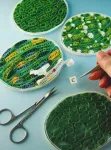(Press-News.org) Giving women in India's Madhya Pradesh state greater digital control over their wages encouraged them to enter the labor force and liberalized their beliefs about working women, concluded a new study co-authored by Yale economists Rohini Pande and Charity Troyer Moore.
The study, published in the American Economic Review, found that a relatively simple intervention directed to poor women -- providing them access to their own bank accounts and direct deposit for their earnings from a federal workfare program, along with basic training on how to use local bank kiosks -- increased the amount they worked, both in the government program and for other employers.
The women who had access to the banking resources were more likely to report in surveys that a working woman made "a better wife" and that husbands with working wives were better spouses and providers. They also were less likely to say women who work outside the home bear social costs for it.
The study points to the role of gender norms in India's low and declining rate of women in the workforce and it also demonstrates that boosting women's control of their finances can expand their autonomy, said Pande, the Henry J. Heinz II Professor of Economics in Yale's Faculty of Arts and Sciences.
"Economics research often assumes that a country's men and women embrace the same cultural norms, but our study highlights the fact that norms can be differently experienced and held within the same country or culture," said Pande, who is also director of Yale's Economic Growth Center. "Improving a woman's access to her earnings should cause her to work less because she can make the same amount of money with less effort. That we found women work more suggests that some women would prefer to work but are potentially being constrained by social stigma perceived by their husbands' -- specifically, that working wives diminish their husband's social status."
India experienced a period of strong economic growth between 2005 and 2018 with declining fertility rates and gains in education for women, but the rate of female labor force participation fell from 32% to 21% during that period. However, one-third of Indian housewives say in surveys that they are interested in working outside the home. Bringing these latent workers into the workforce would contribute substantially to the country's economic growth, Pande said.
Working in northern Madhya Pradesh, a region marked by particularly restrictive gender norms, the research team collaborated with government and banking partners to enable direct deposit of women's wages from the federal workfare program into their own bank accounts rather than into a male-controlled household account. They conducted a randomized controlled trial covering 197 village clusters and surveyed a total of 4,300 women. The villages were divided among a control group and four treatment groups, only one of which received bank accounts, direct deposit, and training. The researchers refer to this group as being "digitally empowered."
The study found an overall increase in labor supply among digitally empowered women compared to women who only received a bank account. They were 28% more likely to have participated in the workfare program during the past year than were the women who only received a bank account and 13% more likely to report any paid work in the previous month, according to the findings. The digitally empowered group also earned 24% more (950 rupees) annually from the private sector, which is notable given that the direct deposit was only linked to workfare wages and private-sector work often is paid in cash.
"The fact that digitally empowered women were earning more in the private sector suggests that having more control of their earnings spread into other aspects of their lives, giving them the ability to negotiate with other household members to work more outside their homes," said Troyer Moore, director of South Asia economics research at Yale's MacMillan Center for International and Area Studies. "It tells us that a simple policy intervention has altered a cultural norm, which is very exciting."
The researchers separated the sample into two groups: women who had worked in the government program before, and those who had not. In surveys, women in the latter group reported having less decision-making power, and that their husbands were more likely to associate a working wife with social stigma. The data showed that while the increases in work outside the home trailed off among those who had previously worked in the program by the study's third year, it persisted for the socially constrained group, demonstrating that the intervention had the most durable impact on women facing the greatest barriers to work.
Study participants were surveyed to measure their thoughts about working and non-working women. The results showed that, compared to women who received only bank accounts, digitally empowered women liberalized their personal beliefs about women's work.
While researchers were conducting the study, the Indian government began scaling up direct deposit of workfare wages into female-owned accounts nationwide, but the effort involved neither targeted outreach to eligible women nor any systematic account training, key elements of the most successful intervention that the study identified, the researchers said.
"We look forward to working with government partners to scale up the policy intervention in a manner that maximizes the benefits to women," Troyer Moore said.
INFORMATION:
The study was co-authored by Erica Field of Duke University, Natalia Rigol of Harvard University, and Simone Schaner of the University of Southern California.
A link to the paper and a detailed summary of its findings is available on the Economic Growth Center's website.
Based on fossil finds, we know that the vast majority of species that once inhabited the earth have become extinct. For example, there are about 5,500 mammal species living on the planet today, but we know of at least 160,000 fossil species, so for every mammal species living today, there are at least 30 extinct ones. We therefore know with great certainty that the lineages of living things come and go along immense time scales. But what factors cause these lineages to come into being and disappear is still an unsolved question.
To investigate ...
Additive manufacturing has the potential to allow one to create parts or products on demand in manufacturing, automotive engineering, and even in outer space. However, it's a challenge to know in advance how a 3D printed object will perform, now and in the future.
Physical experiments -- especially for metal additive manufacturing (AM) -- are slow and costly. Even modeling these systems computationally is expensive and time-consuming.
"The problem is multi-phase and involves gas, liquids, solids, and phase transitions between them," said University of Illinois Ph.D. student Qiming ...
Early 2020 saw the world break into what has been described as a "war-like situation": a pandemic, caused by the severe acute respiratory syndrome-related coronavirus 2 (SARS-CoV-2), the likes of which majority of the living generations across most of the planet have not ever seen. This pandemic has downed economies and resulted in hundreds of thousands of deaths. At the dawn of 2021, vaccines have been deployed, but before populations can be sufficiently vaccinated, effective treatments remain the need of the hour.
Thus, other than fast-tracking research into novel drugs, scientists have also been exploring their ...
Breeding better crops through genetic engineering has been possible for decades, but the use of genetically modified plants has been limited by technical challenges and popular controversies. A new approach potentially solves both of those problems by modifying the energy-producing parts of plant cells and then removing the DNA editing tool so it cannot be inherited by future seeds. The technique was recently demonstrated through proof-of-concept experiments published in the journal Nature Plants by geneticists at the University of Tokyo.
"Now we've got a way to modify chloroplast genes specifically and measure their potential to make a good plant," said Associate Professor Shin-ichi ...
"We know that children use a lot of different information sources in their social environment, including their own knowledge, to learn new words. But the picture that emerges from the existing research is that children have a bag of tricks that they can use", says Manuel Bohn, a researcher at the Max Planck Institute for Evolutionary Anthropology.
For example, if you show a child an object they already know - say a cup - as well as an object they have never seen before, the child will usually think that a word they never heard before belongs with the new object. Why? Children use information ...
In a rapidly changing Arctic, one area might serve as a refuge - a place that could continue to harbor ice-dependent species when conditions in nearby areas become inhospitable. This region north of Greenland and the islands of the Canadian Arctic Archipelago has been termed the Last Ice Area. But research led by the University of Washington suggests that parts of this area are already showing a decline in summer sea ice.
Last August, sea ice north of Greenland showed its vulnerability to the long-term effects of climate change, according to a study published July 1 in the open-access journal Communications Earth & Environment.
"Current thinking is that this area may be the last refuge for ice-dependent ...
Elephants and their forebears were pushed into wipeout by waves of extreme global environmental change, rather than overhunting by early humans, according to new research.
The study, published today in Nature Ecology & Evolution, challenges claims that early human hunters slaughtered prehistoric elephants, mammoths and mastodonts to extinction over millennia. Instead, its findings indicate the extinction of the last mammoths and mastodonts at the end of the last Ice Age marked the end of progressive climate-driven global decline among elephants over millions of years.
Although elephants today are restricted to just three endangered species in the African and Asian tropics, these are survivors of a once far more diverse and widespread group of giant herbivores, known ...
FINDINGS
Men with high-risk prostate cancer with at least one additional aggressive feature have the best outcomes when treated with multiple healthcare disciplines, known as multimodality care, according to a UCLA study led by Dr. Amar Kishan, assistant professor of radiation oncology at the David Geffen School of Medicine at UCLA and a researcher at the UCLA Jonsson Comprehensive Cancer Center.
The study found no difference in prostate cancer-specific deaths across treatment modalities when patients received guideline-concordant multimodality therapy, which in this case was inclusion of hormone therapy for men receiving radiation ...
A water disinfectant created on the spot using just hydrogen and the air around us is millions of times more effective at killing viruses and bacteria than traditional commercial methods, according to scientists from Cardiff University.
Reporting their findings today in the journal Nature Catalysis, the team say the results could revolutionise water disinfection technologies and present an unprecedented opportunity to provide clean water to communities that need it most.
Their new method works by using a catalyst made from gold and palladium that takes in hydrogen and oxygen to form ...
As many expectant mothers know, getting enough folate is key to avoiding neural tube defects in the baby during pregnancy. But for the individuals who carry certain genetic variants, dealing with folate deficiency can be a life-long struggle which can lead to serious neurological and heart problems and even death.
Now a Donnelly Centre study offers clues to how to recognize early those who are most at risk.
Defects in an enzyme called MTHFR, or 5,10-methylenetetrahydrofolate reductase, which modifies folate, or vitamin B9 as it is also known, to produce ...





